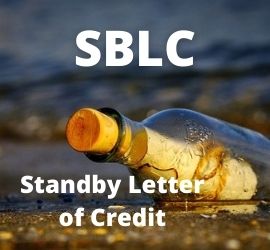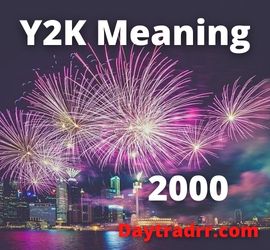SBLC – What Is a Standby Letter of Credit?
 SBLC (Standby Letter of Credit) is a bank guarantee to pay a specific amount of money to a seller if the buyer defaults on the agreement.
SBLC (Standby Letter of Credit) is a bank guarantee to pay a specific amount of money to a seller if the buyer defaults on the agreement.
A standby letter of credit is a legal guarantee by a bank on behalf of its client. It is an enforceable commitment of payment to a seller if the bank’s client defaults on the agreement. An SBLC is used in international or domestic transactions where the seller and the buyer do not know each other or have different laws and regulations. The buyer is certain to receive the goods and the seller is certain to receive payment. However, it doesn’t guarantee the buyer will be happy with the goods. It is strictly an assurance that if goods are delivered, the receiving company is capable of paying the bill or finishing the project.
An SBLC acts as a safety net for the payment of a shipment of physical goods or completed service to the seller. It only activates in the event something unforeseen prevents the buyer from making the scheduled payments. In such a case, the SBLC ensures the payments are made to the seller after fulfillment of the required obligations. From a risk management perspective, an SBLC attempts to hedge the risks associated with such a transaction. Some of the risks include bankruptcy or insufficient cash flows on the part of the buyer. Anything which could prevent them from making payments to the seller on time.
SBLC Standby Letter of Credit Explained
A standby letter of credit is helpful in international trade to help secure a contract. Often, the parties to the contract do not know each other. As a result, the guaranteed payment promotes the seller’s confidence in the transaction. It is a show of good faith and demonstrates the buyer’s credit quality. Further, it assures payment for goods or services even if an unforeseen event occurs. When setting up an SBLC, the buyer’s bank acts as an underwriter to verify and certify the credit quality of the buyer. Once the buyer’s bank is satisfied that the buyer is in good credit standing, the bank sends a notification to the seller’s bank. This contractually assures payment to the seller if the buyer defaults on the agreement. It is a legally enforceable guarantee of payment to the seller.
Approval
The process of obtaining an SBLC is similar to a loan application. The process starts when the buyer applies for an SBLC at a commercial bank. The bank will perform due diligence on the buyer to assess creditworthiness. This is primarily based on past credit history and the most recent credit report. Depending on the credit score, the bank may require the buyer to provide an asset or the funds on deposit as collateral before approval. The level of collateral will depend on the risk involved, the strength of the business, and the amount secured by the SBLC. The buyer will also be required to furnish the bank with information about the seller. This will include shipping documents required for payment, the beneficiary’s bank, and the period when the SBLC is valid.
Fees
After a review of the documentation, the commercial bank will provide an SBLC to the buyer. The bank charges a service fee of 1% to 10% for each year that the financial instrument remains valid. If the buyer meets its obligations in the contract before the due date, the bank will terminate the SBLC without a further charge to the buyer. However, failure by the buyer to meet the terms of the contract requires the seller to present all the required documentation listed in the SBLC to the buyer’s bank within a specified period. If the required terms were properly met, the bank will make the payment due to the seller’s bank. (Source: corporatefinanceinstitute.com)
How an SBLC Standby Letter of Credit Works
An SBLC is most often secured by a business to help it obtain an initial contract. The contract is a “standby” agreement because the bank will have to pay only in a worst-case scenario. Although an SBLC guarantees payment to a seller, the agreement must be followed exactly. For example, a delay in shipping or a misspelling of a company’s name can lead to the bank refusing to make the payment.
There are two main types of SBLC
- A financial SBLC – guarantees payment for goods or services as specified by an agreement. For example, an iron ore refining company might arrange for such a letter to reassure a mining operation that it can pay for a huge delivery of iron ore. The financial-based SBLC guarantees payment for goods or services, as stipulated in the agreement. Consider a mining company that ships ore to a foreign buyer with an expectation that the buyer will pay within 30 days from the date of shipment. If the payment is not made by the required date, the mining operation can collect the payment for goods delivered from the buyer’s bank. Since it is a line of credit, the bank will collect the principal plus interest from the buyer.
- The performance SBLC – is less common. It guarantees that the client will complete the project outlined in a contract. The bank agrees to reimburse the third party if its client fails to complete the project. Further, a performance-based SBLC guarantees the completion of a project within the scheduled timelines. If the bank’s client is unable to complete the project outlined in the contract, then the bank promises to reimburse the third party to the contract a specific sum of money. Performance SBLCs are used in projects that are scheduled for completion within a specific timeline, such as construction projects. The payment serves as a penalty for delays in the project’s completion. It is used to compensate the customer for the inconvenience caused or to pay another contractor to take over the project. (Source: ibid)
Advantages of an SBLC – Standby Letter of Credit
An SBLC is often seen in contracts involving international trade or a large commitment of money with added risks.
- It guarantees payment to the seller – For the business that is presented with an SBLC, the greatest advantage is the assurance of getting paid in a worst-case scenario. Consider an agreement that calls for payment within 30 days of delivery and the payment is not made. The seller can present the SBLC to the buyer’s bank for payment. The seller is guaranteed to be paid.
- Reduces risk to the buyer – An SBLC reduces the risk that the buyer’s order will be changed or canceled. An SBLC helps ensure that the buyer will receive the goods or services that are outlined in the document. For example, consider a contract that calls for the construction of a warehouse. If the builder fails to deliver, the client can present the SBLC to the bank to be made whole.
- Levels the playing field for smaller companies – Another advantage involves global trade. A buyer has an increased certainty that the goods will be delivered from the seller. Typically, small businesses have difficulty competing against bigger and better-known rivals. An SBLC adds credibility and security to a smaller firm’s bid for a project. This can also help avoid an upfront payment or performance deposit.
How To Apply for a Standby Letter of Credit
An SBLC is a combination of a loan and an insurance policy. Therefore, there are many aspects that a bank considers when a commercial customer applies. Ultimately, the key consideration will be whether the amount that is being guaranteed can be repaid. Essentially, it is a combination of credit and insurance for the company submitting the application. As a result, some customers may require collateral to protect the bank in a default scenario. This may come in the form of cash, securities, or the title to a property. The level of collateral required by the bank depends on the size of the SBLC, the risk involved, and the financial strength of the commercial customer.
Application
The procedure for obtaining a SLOC is similar to an application for a loan. The bank issues it only after appraising the creditworthiness of the applicant. Typically, there will be standard due diligence information and questions. Documentation is required regarding the assets of the business and even possibly the owners. Upon receipt and review of the documentation, the bank will either approve or deny the application. If the application is approved, the bank will provide a letter to the business owner. At this point, a fee is then payable by the business owner for each year that the Standby Letter of Credit remains in effect.
The client pays a fee for each year that the letter is valid. Typically, the fee is 1% to 10% of the total obligation per year. In case of an adverse event, the bank must step in to make the required payment to the seller – assuming the seller has met the requirements as laid out in the SBLC. Again, the bank payment to the seller is a form of credit and insurance. In a worst-case scenario where the commercial customer defaults, the bank issuing the SBLC will fulfill its client’s obligations. However, the client is still responsible for paying the principal plus interest as agreed with the bank.
Common Questions
What are the fees for a Standby Letter of Credit?
The standard fee is typically between 1-10% of the SBLC value plus any applicable fees imposed by the bank. If the business meets the contractual obligations before the due date, an SBLC can be withdrawn with no further charges.
SBLC vs LC – What is the difference?
A Standby Letter of Credit is different from a Letter of Credit. An SBLC is paid only after default or after performance conditions have not been fulfilled. However, a Letter of Credit is the guarantee of payment when certain specifications are met and documents are received from the selling party. Letters of credit promote trust in a transaction, due to the nature of international dealings, distance, knowledge of another party, and legal differences.
Is an SBLC safe?
An SBLC is frequently used as an insurance mechanism for the beneficiary or seller. As such, it helps to hedge risks associated with the trade. Simplistically, it is a guarantee of payment that will be issued by a bank on the behalf of a client. It is considered a safe way to conduct business between reputable parties.
How does an SBLC work in international trade?
A financial SBLC may be used where goods are sold to a counter-party in another country. The SBLC ensures their seller will be paid. If there is non-payment, the seller can present the SBLC to the buyer’s bank so that payment is received. A performance SBLC ensures that the criteria surrounding the trade such as timely performance and quality of goods are met. For example, SBLCs are used in construction contracts where the build must fulfill many quality and time specifications. If the contractor does not meet these specifications then there is no need to prove loss or have long protracted negotiations. The SBLC is provided to the bank and payment is then received. (Source: tradefinanceglobal.com)
Up Next: What Are Vendors?
 Vendors are retailers and suppliers contributing goods or services to the next link in economic production or a supply chain.
Vendors are retailers and suppliers contributing goods or services to the next link in economic production or a supply chain.
Vendors make goods and services available to companies or consumers within a supply chain. The term vendor is typically used to describe the company that provides and sells the goods, rather than the manufacturer. However, a vendor within a production chain can operate as both a supplier of goods as well as a manufacturer. The term vendor can encompass retailers or suppliers broadly with what is often a component in a larger product.
A vendor refers to an individual or company that sells something to another individual or entity. Vendors can be utilized at different spots in the supply chain, and with multiple occurrences throughout.




